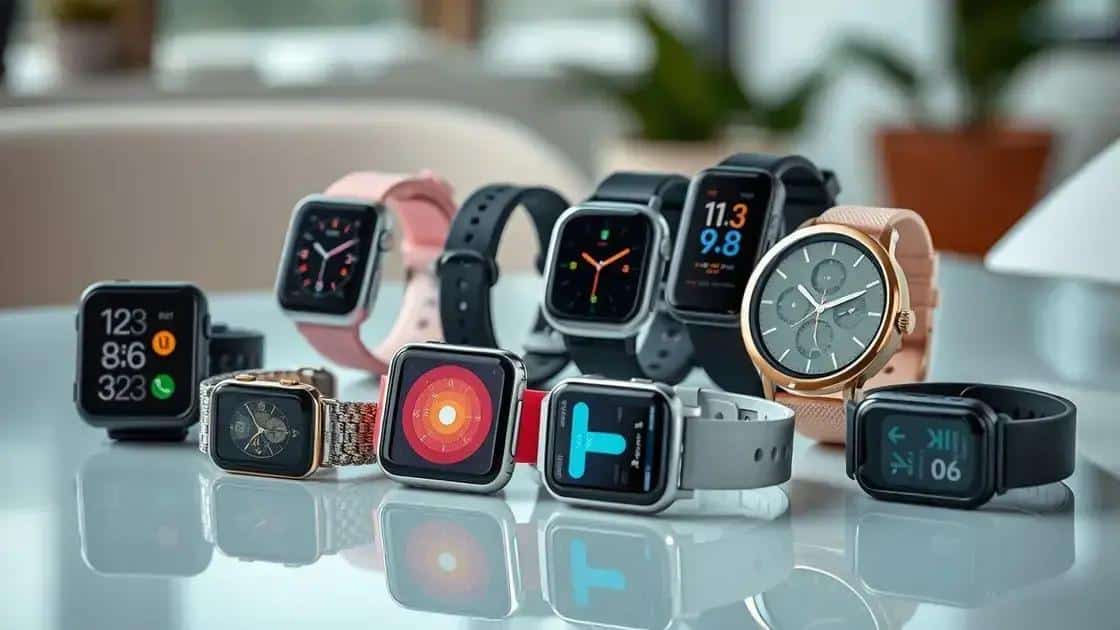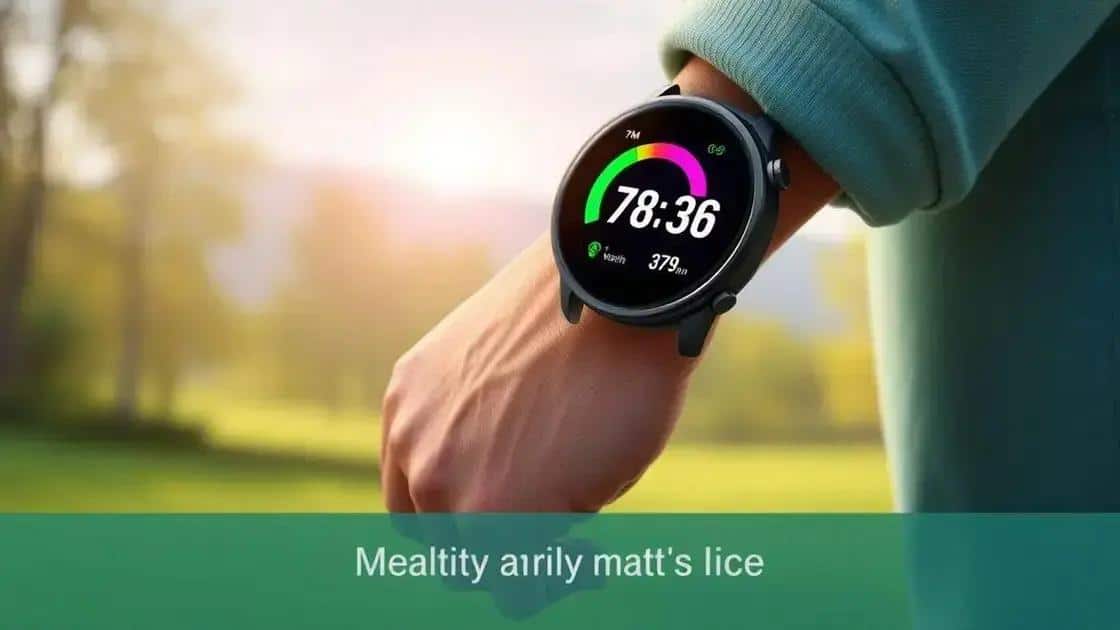Wearable tech innovation trends that will shape the future

Wearable tech innovation trends enhance health monitoring and fitness through advanced features like real-time data tracking, biometric sensors, and smart textiles, while challenges such as cost and privacy concerns impact widespread adoption.
Wearable tech innovation trends are transforming our daily lives, from fitness to healthcare. Are you curious about what the future holds for this dynamic domain? Let’s delve into the advancements that promise to redefine our interactions.
Emerging technologies in wearable devices
Emerging technologies in wearable devices are revolutionizing how we interact with the digital world. With advancements happening at a rapid pace, these devices are becoming smarter, more efficient, and integral to our daily lives. From fitness trackers to smartwatches, the capabilities are expanding, and consumers are reaping the benefits.
Key Features of Emerging Wearable Tech
As we explore the landscape of emerging technologies in wearable devices, several key features stand out:
- Biometric Monitoring: Many new devices come equipped with sensors that can track heart rate, oxygen levels, and even stress levels in real time.
- Augmented Reality: Wearable technology is merging with AR, allowing users to interact with digital information in their physical surroundings.
- Voice Assistance: Voice recognition is becoming a standard, enabling users to operate their devices hands-free.
- Long Battery Life: New advancements are leading to batteries that last longer, making wearables more practical for everyday use.
These features represent just a fraction of the innovation happening in the field. The shift toward integrating artificial intelligence is a significant aspect of this evolution. Smart wearables now analyze data patterns over time, offering personalized insights. For instance, insights from fitness trackers can suggest tailored exercise plans and health tips based on user activity.
Moreover, the integration of IoT (Internet of Things) is enhancing connectivity among devices. Imagine a fitness tracker that communicates seamlessly with your smart refrigerator to suggest healthy meals based on your daily activity levels. This connectivity opens up new possibilities for health management and lifestyle enhancement.
The Future of Wearable Technology
The future is bright for wearable devices. As technology continues to advance, consumers can expect devices that not only monitor health but also enhance overall well-being. The advancements in materials science are leading to more comfortable and stylish wearables, making them more appealing.
In conclusion, the emerging technologies in wearable devices are changing our everyday interactions with the world around us. As these innovations pave the way for a more connected and health-conscious society, the potential for growth and development in this field is limitless.
How wearable tech improves health monitoring

Wearable tech is transforming the landscape of health monitoring. By integrating advanced sensors and innovative technology into everyday devices, individuals can now track their health more accurately and conveniently. These devices empower users to take control of their health through real-time data.
Key Benefits of Wearable Tech in Health Monitoring
One significant advantage is the ability to monitor vital signs continuously. This can include:
- Heart Rate Tracking: Wearables provide immediate feedback on heart rate fluctuations, alerting users to potential health issues.
- Sleep Quality Analysis: Many devices track sleep patterns, helping users understand their sleep quality and make improvements.
- Activity Tracking: Wearables encourage physical activity by monitoring steps taken and calories burned, contributing to healthier lifestyles.
- Health Alerts: Users receive notifications about irregular heart rhythms or other abnormalities, which can be crucial for timely medical intervention.
Furthermore, the integration of technology with mobile apps enhances the user experience. These apps often sync with wearables, allowing users to analyze their data over time. This connection helps set goals and offers personalized recommendations based on past behavior.
Many wearables now support connectivity with healthcare providers. This connectivity allows for remote monitoring of patients, crucial for managing chronic conditions. For instance, heart patients can share their vital signs with doctors in real time, enabling faster and more informed decisions regarding treatment.
The Future of Health Monitoring with Wearables
Looking ahead, the evolution of wearable technology promises even more capabilities. Innovations like AI-driven analytics and machine learning are set to personalize health insights further. By predicting health events before they occur, wearables can significantly enhance patient outcomes.
Overall, wearable tech is not just about convenience; it has become an essential part of modern health monitoring, significantly impacting how we manage and understand our health.
The future of fitness trackers and smart clothing
The future of fitness trackers and smart clothing is bright and full of exciting possibilities. As technology continues to evolve, these wearables are set to become an even more integral part of our daily lives. Users can expect enhanced features that cater to their health and fitness goals.
Innovative Features on the Horizon
New enhancements are emerging that will revolutionize how we view fitness trackers. Some futuristic features include:
- Biomechanical Sensors: These sensors will provide data on body mechanics, aiding in improved workout techniques.
- Smart Textiles: Clothing with embedded sensors can monitor heart rate, body temperature, and more, providing real-time feedback during workouts.
- AI Integration: Artificial intelligence will analyze performance and suggest tailored workouts to optimize results.
- Biofeedback Technology: Wearables may provide feedback through vibrations or alerts to help users adjust their performance instantly.
As fitness trackers get smarter, their role in promoting health will expand. For example, deeper integration with health apps will allow for a more comprehensive view of one’s fitness journey. Users will receive customized insights that track not only workouts but also nutrition and sleep patterns.
Moreover, smart clothing will take personal fitness to a new level. Imagine wearing a shirt that tracks your workout intensity and adjusts according to your performance. This kind of technology will help in preventing injuries and ensuring optimal effort throughout exercises.
Potential Impacts on Health and Wellness
The increasing sophistication of these devices could lead to significant changes in wellness practices. With detailed metrics at their fingertips, users are likely to make more informed decisions about their health. This could result in increased motivation and adherence to exercise regimens.
Ultimately, the future of fitness trackers and smart clothing is not only about tracking activity; it’s about creating a holistic approach to health and fitness. With ongoing advancements in wearable technology, people will be empowered to take charge of their well-being like never before.
Challenges in wearable tech adoption

Challenges in wearable tech adoption can hinder the growth of this exciting technology. While many people are eager to use wearables, several barriers exist that impact their acceptance and usage.
Common Barriers to Adoption
One major challenge is the cost of devices. High-quality wearables can be expensive, making it difficult for some individuals to invest. This barrier often prevents potential users from experiencing the benefits of these technologies.
- Lack of Understanding: Many potential users may not fully understand how wearables work or their potential benefits.
- Privacy Concerns: Users worry about data security and how personal information is collected and used by companies.
- Battery Life: Short battery life can frustrate users, as frequent charging can be inconvenient.
- Inaccurate Data: Some wearables may not provide reliable data, leading to skepticism about their usefulness.
Another issue is the perception of wearables. Some people view these devices as unnecessary gadgets rather than essential health tools. This perception can limit interest and decrease the likelihood of adoption.
Additionally, there are technical challenges. For example, ensuring compatibility with various smartphones and apps can create barriers for users who are not tech-savvy. The constant updates and learning curves can deter individuals from using wearables regularly.
Overcoming Adoption Challenges
Addressing these challenges is crucial for increasing adoption rates. Companies can focus on educating potential users about the benefits of wearables. This includes highlighting how wearables can help improve health and fitness, creating a compelling case for investment.
Furthermore, improving the user experience is essential. Manufacturers can focus on making devices more user-friendly and ensure that they offer reliable and accurate data. Innovations that extend battery life will also enhance overall satisfaction with wearable technology.
FAQ – Frequently Asked Questions about Wearable Tech
What are the main benefits of using wearable tech?
Wearable tech helps monitor health, track fitness, and provide real-time data, making it easier to achieve health and fitness goals.
What challenges do people face with wearable tech adoption?
Common challenges include cost, privacy concerns, battery life, and lack of understanding of how the devices work.
How does wearable tech improve health monitoring?
Wearable tech provides continuous data on vital signs, encouraging healthier habits and alerting users to potential health issues.
What is the future of fitness trackers?
The future includes advanced features like AI integration, smart textiles, and improved user experience, making wearables more effective and user-friendly.





